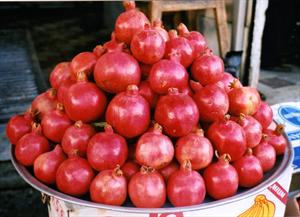Pomegranates Fruiting in England

Pomegranates on sale in Iran
The pomegranate needs a mild-temperate to subtropical climate. At home in its native Iran and neighbouring Iraq and Syria, it has been cultivated around the Mediterranean since ancient times, giving its name to Granada in southern Spain, but not adapted to our climate. Pomegranates are planted in England for the ornamental value of their young coppery leaves and showy scarlet, funnel-shaped flowers and, according to the gardening authorities, only fruit after a long hot summer. The pomegranate at St Johns has cropped for the last few years, although not before, the head gardener told me. That it now produces fruit be believes is due to our recent mild winters and hot summers.
We hear of persimmon fruiting in Kent and loquats in London gardens, it would be interesting to hear what other tender fruits are now finding the English climate congenial.
Joan Morgan
Published: 31 May 07
Author: Joan Morgan
To comment on this article please visit our blog.
